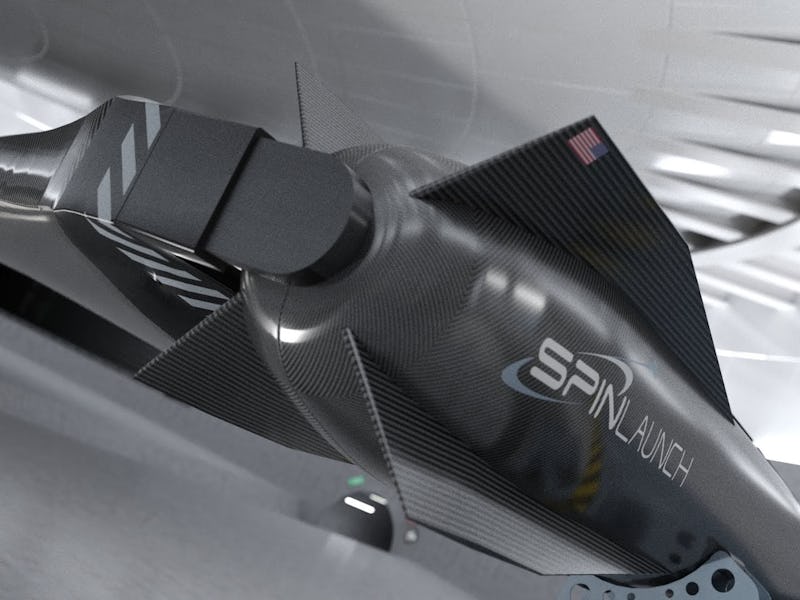New technology would literally throw satellites into orbit
For today’s commercial space companies providing launch services to orbit, the name of the game is simple: “do it cheaper.”

For today’s commercial space companies providing launch services to orbit, the name of the game is simple: “Do it cheaper.” To reduce the costs of launching payloads to space and encourage the commercialization of Low Earth Orbit (LEO), entrepreneurs have turned to everything from reusable rockets and 3-D printing to air-launch vehicles and high-altitude balloons. And yet, there is one concept that genuinely seems like something out of this world!
This concept is known as a mass accelerator, a kinetic energy space launch system alternative to chemical rockets. Recently, the commercial space company SpinLaunch conducted the first launch test of its Suborbital Accelerator for the first time. The success of this vertical test is a crucial stepping stone towards creating the company’s proposed Orbital Launch System (OLS), which will conduct regular payload launches soon.
In 2018, Universe Today reported on how SpinLaunch and its CEO Jonathan Yaney had come out of “stealth mode” and sought Series A funding. By 2019, the company broke ground on its test facility at Spaceport America, followed by constructing the Suborbital Accelerator. Measuring 33 meters in diameter (108 ft) in diameter, the Suborbital Accelerator is the world’s tallest instrument of its kind and costs about $38 million to build.
The system is a one-third-scale model of the OLS system that is currently under development and relies on the same components. Like the OLS, the Suborbital Accelerator uses a vacuum-sealed centrifuge to spin a rocket and then catapult it to space at up to 8,000 km/h (5,000 mph). The rotational kinetic energy comes from ground-based electricity provided by solar and wind (which would eliminate the carbon footprint of rocket launches).
Once the rocket reaches an altitude of roughly 61,000 m (200,000 ft), the rocket ignites its engines to reach a speed of 28,200 km/h (17,500 mph) and reach Low Earth Orbit (LEO). If successful, this system will vastly reduce the associated cost and energy of sending payloads to space while increasing the frequency of launches. According to projections, the OLS will reduce the cost of individual space launched by a factor of 20.
Since the 1960s, NASA has been exploring this technology as an alternative to rocket launches. While it was never used, NASA has continued to develop this technology through the Marshall Space Flight Center and the Kennedy Space Center. Here, engineers have been working on concepts like the Magnetic Levitation (MagLev) System to launch spaceplanes horizontally using scramjets on an electrified track.
The SpinLaunch test took place on October 22, 2021, where the Suborbital Accelerator (a technology demonstrator) was powered up at the company’s flight test facility — located at Spaceport America in the deserts of New Mexico. For this test, the Suborbital Accelerator was powered up to 20% of its total capacity and reportedly launched a 3 meter (10 foot) passive projectile to an altitude of “tens of thousands of feet” (see video below).
Scott McLaughlin, Spaceport America’s executive director, witnessed the successful test launch. As he was quoted as saying by Aerospace Testing International:
“In just a little over two years [...] SpinLaunch was able to bring their site to life and conduct their first high-altitude operational launch. We are very happy for them and expect that they will be important contributors to New Mexico’s growing aerospace ecosystem for years to come.”
With this first test under its belt, SpinLaunch will be moving ahead with developing its full-scale accelerator, which will measure 100 meters (328 ft) in diameter and be capable of launching payloads in the 20 to 200 kg range (44 to 440 lbs). The payload types they envision include various kinds of satellites, space-based solar arrays, and electric propulsion modules.
The company has tested its high-g reaction wheels — which included a 12m (~40 foot) variant – with multiple types of payload and reported that even “unmodified smartphones, action cameras, and telescope lenses have survived without damage.” At the same time, the company is also working on ways to “ruggedize” satellites for the high-g conditions associated with kinetic launches. As they state on their website:
“SpinLaunch is engineering a variety of efficient satellite chassis, which require no more than a 10% increase in mass compared to those designed for the traditional launch environment. Satellite structures optimized for the high-g environment are readily analyzed with finite element modeling with predictions that closely match real-world testing, allowing for rapid iteration and development. The net result is a family of structural components that are ready-to-use with little to no impact to mass or cost.”
In less than a decade, the commercial space sector has vastly increased access to space. The key to it all was leveraging new technologies and innovation so that boosters can be retrieved and reused, satellites can be smaller, and new classes of space vehicles and launch methods can be utilized. Looking to the next decade, our presence in space will grow exponentially, thanks to further breakthroughs in engine technology, fuels, and materials science.
There may even come a day when chemical rockets are no longer necessary to get to space, though they may still be helpful. In an ironic twist, the future of space may rely on kinetics and other launch methods that don’t come down to the Rocket Equation, the very thing that got us to play in the first place! But such has always been the nature of rocket boosters. They’re delivery mechanisms and not meant to accompany us once we’ve broken free of Earth.
This article was originally published on Universe Today by Matt Williams. Read the original article here.
This article was originally published on